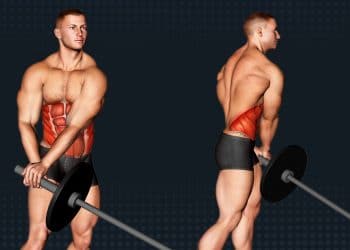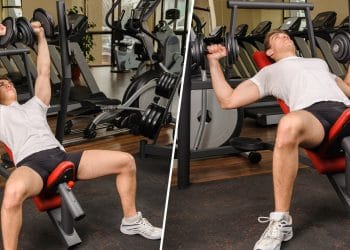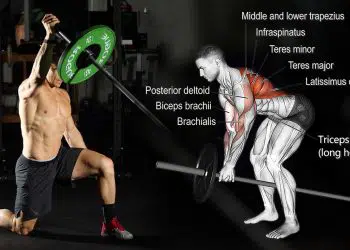The landmine press is an exercise that involves pressing one end of a barbell at an angle while the other end is either secured to a dedicated landmine setup or the corner of a wall.
Landmine Press is a great movement for engaging the shoulders, chest, triceps, and core while reducing stress and strain which is very beneficial for many people. But it’s also an exercise that can be utilized to improve overall fitness and all different types of people from athletes to your average gym-goer can benefit from it. Plus, it also teaches some important movement principles.
So, let us talk you through the landmine press and we’re hoping by the end you’ll consider giving it a try or adding it to your routine regularly.
How To Do The Landmine Press
This is a rather simple exercise that anyone can do safely and effectively. And there can be several different ways to execute the movement but we’ll break down the basics in a step-by-step process…
Note: You can use one or two hands for this exercise and if you find it easier, start with the end of the barbell on a bench.
Two-Arm Variation
Step 1: Lift the bar all the way up to chest level and grip the very end with two hands (one on top of the other or interlocked) and take a hip-width stance but angle your body slightly into the bar rather than standing completely straight for better stability.
Level Up Your Fitness: Join our 💪 strong community in Fitness Volt Newsletter. Get daily inspiration, expert-backed workouts, nutrition tips, the latest in strength sports, and the support you need to reach your goals. Subscribe for free!
Step 2: With your core engaged and elbows at 45 degrees to your torso, press the weight up until your arms are fully extended while leaning forward slightly into the movement to create full shoulder rotation.
Then slowly return to the starting position.
Full shoulder rotation and extension are important for getting the full benefit of this movement and leaning forward during the press is essential for preventing back extension (especially with heavier poundages) which you don’t want. Also, you don’t want to bring the elbows behind the body but rather just to the torso in the starting position.
One-Arm Variation
Step 1: Lift the bar to chest level while holding the end with one hand in a pressing position and take a split stance or hip-width stance. For example, if pressing with your left arm, place your right leg in front and left leg behind.
Step 2: Press the bar until your arm is fully extended while leaning forward slightly to get full shoulder rotation.
Step 3: Bring the bar back down slowly until your elbows just reach the side of your torso and repeat.
Technique should be similar to the one-arm variation with a hip-width stance but you want a very slight rotation of the trunk with the split stance to maximize arm extension.
Benefits Of The Landmine Press
The landmine press has several benefits that make it worthwhile which include hypertrophy and strength in the chest, shoulders, and triceps, explosiveness, improved power output, unilateral function, core stability, and scapular stabilization.
The one-arm variation improves unilateral function because you’re activating muscle, strength, and function one side at a time. Unilateral training improves stability, balance, and functional fitness, plus, it’s a great way to correct imbalances and prevent overuse of one side. (1)
But you can really train your obliques and overall core due to the stabilization and slight rotation and prevention of rotational forces during the eccentric (negative) portion.
Not to mention, training a muscle on one side of your body stimulates and improves strength in the same, opposite side muscle through a neural occurrence called cross-education of muscles. For example, pressing with your left side will also stimulate the muscles on your right side.
This is excellent for facilitating rehabilitation in an area which is one big advantage over bilateral (affecting both sides) training.
Then for core stability, having to balance the bar and keep it in a relatively straight path will activate your abdominals and obliques.
And exercises that involve pressing movements also require adequate scapular stability in order to maximize the ball and socket function for optimal overhead pressing technique and function. So, that is why your arm and body position are so essential to performing this exercise effectively. There’s a degree of retraction of the shoulder blades against the scapula during the start and first part of the press, followed by extension to finish off the press.
Also, the landmine press is a very good alternative for those who usually tend to experience shoulder pain during other pressing movements. Having your elbows placed more in front of you is an effective way to eliminate shoulder discomfort plus it’s an ideal way to press with more power on the angled bar.
The landmine press is really an excellent exercise for anyone regardless of the situation or goal. It’s a great addition to improving aesthetics and overall functional which creates big carryover to athletic and daily activities.
4 Landmine Press Variations
We described how to perform the basic standing two-arm and one-arm versions so we won’t include either in the variations.
Half-kneeling One-Arm Landmine Press
For this variation, you’ll kneel down on one knee placing your other leg in front and press the bar using your opposite arm. You still want to ensure you maintain the same technique as described in the above instructions.
Landmine Push Press
The push press is a popular variation used for many standing pressing exercises. But the whole purpose is to get some assistance from your lower body in order to be able to handle heavier weight which is very beneficial for making strength progress.
You can do this with either one or two arms.
Banded Landmine Press
You can opt for bands instead of weight plates when looking to add more resistance to this exercise.
So, for this variation, you’ll basically wrap one end of a band around your foot or a base, and the other around the end of the barbell. You’ll have constant resistance this way while taking advantage of the strength and muscle-building benefits.
You can also place the band around both feet in a hip-width stance. Also, you can do either the one or two-arm variation.
Landmine Press and Catch
This variation basically involves pressing the bar in an alternating fashion back and forth or with the same hand. You can even use a little push from the legs for this variation.
Also, you can do this variation kneeling or even with two hands.
Best Uses For The Landmine Press
Hypertrophy and strength
You can add a decent amount of weight to the bar, which makes it a great way to build muscle and strength. Now, you may not want to train with ultra-heavy loads because you still have to maintain a safe posture. However, advanced lifters will know how to better program this movement into their training while using maximum poundages.
Aim for 6-12 reps to remain within a good hypertrophic and strength-building range.
Function/athletics
The landmine press can be used for improving not only stability and a better pressing movement but you can train explosively for athletics and general power output improvement since the landmine press has this sort of functional carryover.
So, you can train with light to moderate loads and effectively work on your speed/explosiveness.
The functional aspect of having to stabilize, balance and engage your core is beneficial for maintaining optimal full-body performance during weight training in general, plus everyday activities.
And even elderly individuals can benefit greatly from the landmine press because it will help greatly with physical activities.
Final Thoughts
The landmine press is one exercise that you’ll definitely appreciate incorporating into your pressing workouts.
It’ll blast your upper body muscles and the benefits go beyond just aesthetics and strength. You’ll improve full-body function and possibly reduce stress and stress typically with other similar exercises.
So, try it out and include some variations to mix up your training and even make some gains in the process.





